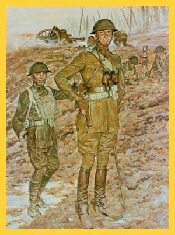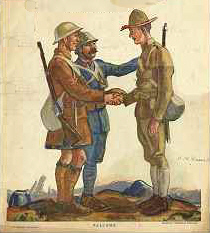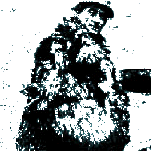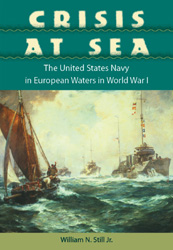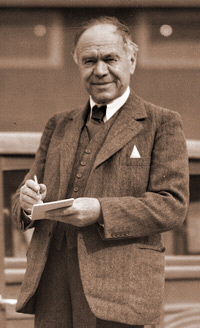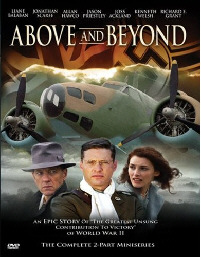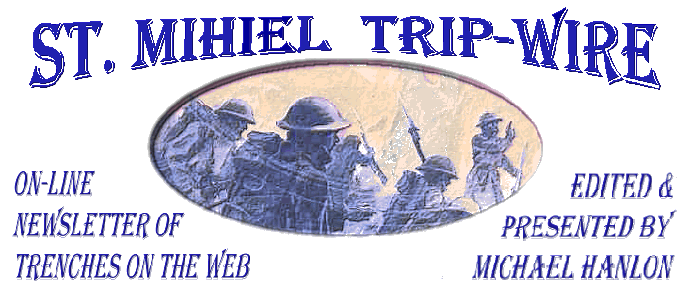
April 2007 |
Access Archives |
TRENCH REPORT: April will see the rededication of the Canadian Vimy Ridge Memorial, so next month we will providing a special report on the festivities in our next issue. However, in the following month I'll be visiting the memorial with my 2007 Western Front Tour, and I'll be following up with an eyewitness report on the improvements at the Memorial Park. While we are in Europe, I'll be meeting some of the contributors you've read here at the Trip-Wire: Christina Holstein and Tony Noyes will be meeting us at Verdun; Jeffrey Aarnio will be showing us the Oise-Aisne U.S. Cemetery where he is now superintendent; Doug Mastriano's team will be guiding us around the Sgt. York trail at Châtel-Chéhéry; Fred Castier will be meeting us at Cantigny, where he is developing a visitors' center, and Tony Langley will be joining us for our tour of the Liège Forts and Mons. I can hardly wait and, of course, you will be seeing photos of all our friends and the tour members here on the Trip-Wire. MH
 German Aviator Max Immelmann in an
|
||||||||||||||||||||||||||||||||||||||||||||
New at Our Own & Our Friends' Great War WebsitesClick on Title to Access |
|
New from Members & Sister Organizations Our friend and fellow WFA & GWS member Werner Gruhl has written a remarkable book about Japan in the Second World War. I found some of the information it contained about the scope of the war in the Pacific surprising and sometimes shocking. Click on the banner to visit his website to learn about the book and get a view of the eye-opening statistical tables Werner compiled to back his conclusions. At Great War Society Sites
|

Alain-Fournier [Henri Alban-Fournier], author of the French romantic classic Le Grand Meaules, disappeared with twenty other men from R.I. 288 near Éparges Spur in the St. Mihiel Salient on September 22, 1914. Their bodies were discovered in 1991 after research in German archives. The forest glade where two other officers and fifteen enlisted men were discovered is now the site of two monuments: a glass pyramid commemorating the group and a stylized sculpture of a flame inspired by Alain-Fournier's literary works.
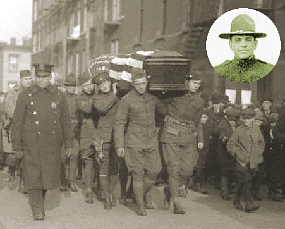
Funeral of Doughboy Monk Eastman,
27th NY Division, December 30, 1920
(Returning to His Gangster's Life After Serving Honorably with the AEF, Monk Sadly Met a Gangster's Fate) (article)
|
Old Bill Helping the Veterans' Cause By Bruce Bairnsfather, Postwar 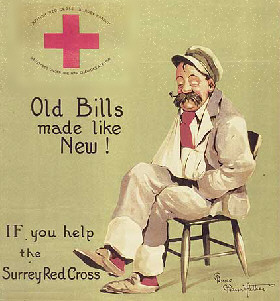
|
GREAT WAR 2007 EVENT CALENDAR | |
|
League of World War I Aviation Historians May 11-12, 2007 Holiday Inn Rosslyn in Arlington, VA (link) | |
|
Palestine Campaign International Conference September 3-6, 2007 Tel-Hai Academic College in Upper Galilee, Israel (email for details) | |
|
Each Other For WFA-USA 18th National Seminar September 7-9, 2007 Naval War College Newport, RI (Full Program) | |
|
The Huntington Library, October 5-6, 2007 San Marino, CA (email for info.) | |
|
International Conference October 18-20, 2007 Georgetown University, Wash., D.C. (link) | |
|
U.S. Branch Chapter Meetings Check for Your Region Regularly Updated (details) | |
|
Berkeley, San Francisco and Palo Alto, CA Regularly Updated (details) | |
|
Email Response |
|
|
WFA and the Imperial War Museum Collaborate on Mapping the Front
The Western Front Association (UK) and the Imperial War Museum have announced the imminent availability of a series of DVD maps and aerial photographs from their archives. The project, called Mapping the Front, is aimed not only at those with an interest in military history but also to family historians, social and political historians and cartographers. Locations will include the Somme, Arras, Ypres, and Gallipoli in addition to lesser known battlefields such as Loos. Other themes will include cemeteries, cartography, transport, tanks and artillery. For details refer to the WFA Bulletin and the WFA-UK website (link).
A tunic, cap, letters and a box of ammo from the Spad XIII flown by No.1 U.S. air ace Capt. Eddie Rickenbacker is due to be auctioned by James D. Julia of Portsmouth, NH at their next sale, on October 6-8. (link)
The Flanders Field Museum in Ypres has announced a 90th Anniversary program for the Battle of Passchendaele, November 15-17, 2007. We will have more details in future issues.
 |
Winston Churchill, then First Lord of the Admiralty, summing up the British perspective in a secret memorandum to Canada's prime minister in August 1912.

Die Wacht am Rhein: 1914
Click Here for News on Travel Opportunities |

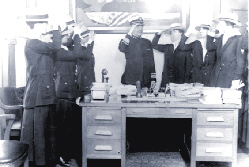 The "Yeomanettes" Bless Their Memory |
Two French veterans passed away recently. Jean Grelaud, 108, died Feb. 25 in Paris. He was mobilized in 1917, serving in the 31st and the 131st infantry regiment. During the Second Battle of the Marne, he was captured and interned in Belgium before being freed Nov. 21, 1918. Another World War I veteran from France, Rene Riffaud, died Jan. 16. Like Grelaud, he was 108.(link)
Last month, we reported the death of Howard V. Ramsey, of Oregon. It has subsequently been written that he was the last surviving American to have seen combat in the Great War. (link)
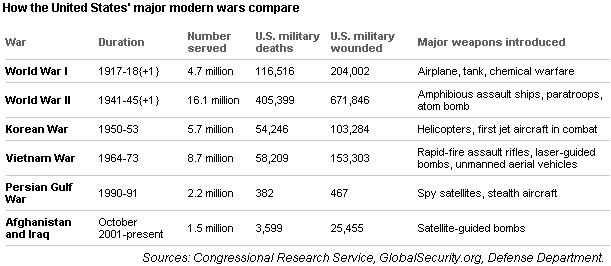 |
 |
Winter at Verdun II
By Christina Holstein
Verdun area in winter. Here is her 2007 set. MH]
At the end of this 2006-07 "winter of discontent" for snow-lovers, here is a
series of pictures of Verdun taken on a rare snowy day.

2. The cemetery is the Faubourg Pavé military cemetery, and the trees around the central cross guard the graves of the men who were not chosen to be the French Unknown Warrior. Brought from various sectors of the Western Front, these bodies were placed in the Citadel, and a young soldier was asked to choose one of them to lie in state in Paris. The chosen coffin was taken by train from Verdun to Paris, and the others were buried in this cemetery, close to the road along which the soldiers marched to the battlefield.
3. Two positions around Fort Tavannes. 3a. This strange-looking object is a machine gun bunker close to the fort. Designed by Pamart and installed after the battle, it features two apertures and a long dividing 'snout', which normally makes it look like a prehistoric animal. Buried under snow, it looks more like a heavily iced cake with currant 'eyes'. 3b. This small arms position from 1917 stands close to Fort Tavannes. It is part of a series of defences built after the battle and is the only one of its kind. It allows for fire in all directions.
4. The Verdun waterfront on a cold day with the fountains playing - too cold for a glass of wine at a table by the river.
5. The Victory monument on the main street. Built on the site of the old Madeleine Church, the brooding warrior looks towards the battlefield, his hands resting in the hilt of his sword. The meaning of the stance is 'Thus far and no farther'.
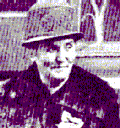 Madame Belmont-Gobert |
During the August 1914 Battle of Le Cateau, Trooper Patrick Fowler of the 11th Hussars, Prince Albert's Own, was cut off from his regiment behind German lines. After hiding in the woods for months, the hungry, exhausted cavalryman was found by Louis Basquin and taken to the home of his mother-in-law, Madame Belmont-Gobert, in the village of Bertry. For the next four years, she successfully hid him, usually in her cupboard, despite being compelled to billet German troops. At times German soldiers sat, ate, talked and smoked just a few feet from where Fowler was hiding. Once Madame had a premonition that the cupboard would be searched, so she hid the hussar under a mattress. Indeed, the German inspectors that day--for the only time--opened the cupboard. Trooper Fowler was rescued by advancing British forces in October 1918, although he needed his former commander's testimony to avoid desertion charges. Madame was awarded the Order of the British Empire for her courage. The cupboard is now in the collection of the Imperial War Museum. |


Delivering the Wine Ration Was a High Priority Task for the Poilus
 |
1917 on The Western Front | |
|
On Easter Monday April 9th on Vimy Ridge and in a bitingly cold dawn the troops attacked and took the majority of the ridge within 24 hours and the remainder within 48. This removed the German's view and control of the Douai plain and its many coalfields and opened the way for the Battle of Arras to start the next week. Again, the Arras planning was exemplary, and the two British armies, under Sir Henry Horne and Sir Edmund Allenby, still ably assisted by the Canadians and, later, the Australians, were initially very successful. An attempt was made at Bullecourt to break the Hindenburg line but was unsuccessful and cost the Australians many losses. The ground taken in the Arras battle stretched from Lens in the north to the north of Bullecourt, more than thirty miles, to a maximum depth of some four miles. The casualties in April amounted to some 103,000, a rate higher than that of the Somme the previous year. However, the Nivelle Offensive, begun April 16th, was ending in failure. Nivelle's security and secrecy was basically nil, and the Germans were well prepared for the initial artillery onslaught of some 5,360 guns, drawing back to their second lines and thus avoiding decimation in the opening hours. In blinding snow storms the French advanced to the German wire, finding the frontline trenches generally unoccupied. They were then hit by intense artillery and small arms fire while trying to move through the barbed wire. The battle plans called for the assaulting waves to continue moving forward, and thus a bottleneck concertina effect came into being with many waves of infantry crushing into a small space. This provided even better targets for the defenders, and the losses rose tremendously. The men, under intense fire, took what shelter they could find, and still the casualties rose, possibly to over 100,000 the first day. Rumour among the troops converted this figure into 100,000 dead. Nivelle had promised the politicians that he would stop the attack if it was not successful within 48 hours. |
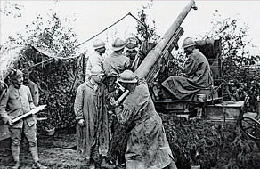 French Artillery in ActionStaff officer's mismanagement (in my opinion) of instructions to units on the battlefield resulted in some being pulled out immediately and some being left out under fire for days. Some were even pulled out to rest and immediately sent back into the furnace. Nivelle had promised his men that this would be the last great effort that was necessary to begin to end the war. It wasn't, the men knew it, and they said, "Why should we keep on sustaining these terrible losses when the staff don't care and we just go on hanging on the (barbed) wire." Some units out of the line in Soissons either refused to go back up the line or only agreed to do so if they held the line but were not required to assault the seemingly impregnable German defences. Their officers had little control over these large bodies of men and the "acts of collective indiscipline" spread rapidly from the end of April into May. The Battle of Arras was initially successful but then had to be extended by Haig after his realisation that there was something radically wrong with the Nivelle offensive and that German resistance had significantly strengthened. America entered the war but was very far from ready in any sense. On the Western Front stalemate had returned.
| |||||
|
|
||||||
|
| ||||||
With the news [above] that America's last combat veteran of the Great War, Howard Ramsey, has left us, I thought it was fitting to present this reflection on the passing of a generation. MH. At the signing of the Armistice that ended World War I in Europe, there were almost five million men under arms in the American military, and two million of them were in the American Expeditionary Force (AEF) in France and Belgium. Before the last of the old veterans leaves us forever, it behooves us to take a nostalgic look backward at our inimitable Doughboys of 1917-1919.
Today, among most Americans, the Doughboy's war is only vaguely recalled, a misty promontory obscured by a war that preceded it and the one that followed it, the Civil War and World War II. It seems to have something to do with poppies, ghostly figures in gas masks, and a rousing tune, "Over There". In family albums are sometimes seen sepia-toned images of an unbelievably young grandfather or great-grandfather wearing the Doughboy's tin helmet or high-crowned felt hat, spiral puttees , and a wool tunic with a high collar that appears to have been choking him. Such young American soldiers, though, poured into the ports of France during 1917 and 1918. The American Expeditionary Force arrived radiating confidence in themselves, with a determination to show the world that they were better than any soldiers that Europe had ever produced, and this definitely included the Germans. They were also poorly trained, ill equipped, and had to rely upon the French and the English for all of their artillery, tanks, horses, and for a large part of their food, but even these handicaps did little to stifle their spirit and their enthusiasm. They made themselves at home in France and established a reputation with and among the French people as having been kindly, happy, very ingenious, and very helpful to everyone. They somehow hurdled the language barriers and made friends with the peasant family with whom they were billeted and with every child that was within reaching distance. When asked if they could capture Cantigny, the Americans said they could, and they did. The same applied to Belleau Wood, Blanc Mont ridge, the St. Mihiel salient, and the Argonne Forest. The deeds of the old AEF on the field of battle are of such brilliant stature that they will ever be remembered by our sister country, La Belle France, and wondered at by every generation that has succeeded that of those who went to France to "make the world safe for democracy". 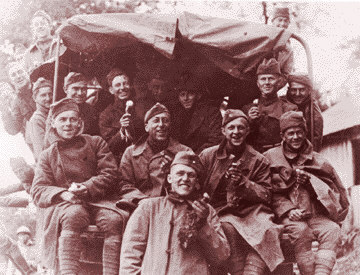 As We Will Always Remember Them | ||||||
Last month we presented a review of An Ace Minus One; in this issue of the Trip-Wire we share reviewer Donna Cunningham's interview with the author.
TMM: Jack is a composite of many people that I incorporated both consciously and subconsciously. I borrowed reminiscences of multiple people, such as ambulance drivers, pilot in North Africa, etc. The early scenes of him in Eveleth, Minnesota I actually borrowed from my grandfather. My grandfather, who would have been the same age as Jack, often told us about going to dances at the Finnish Hall and driving lumberjacks to the town brothel in his Model-T. I wanted to show Jack as somewhat naive in the beginning but one who catches on quick. DC: The scope of the novel is huge. How did you do your research on World War I? TMM: I am a voracious reader myself, so I read much about World War I. Now there is a huge amount of information on the internet, such as sites like theaerodrome.com. I also visited insightful museums such as the Imperial War Museum in London and multiple museums and battlefields in France, including L'Invalides. DC: How did your experience as a pilot influence you? TMM: I have over 2000 hours as a military pilot, primarily as an instructor. Many of the experiences and close calls I had were benign compared to what I could imagine in a rickety open-cockpit biplane. For example: flying on the wing during a descent though heavy clouds. I remember that I didn't dare take my eyes off my leader, not even to glance at my instruments, because I could barely see his plane even though his wing tip was less than three feet from my own. In that situation one can become disorientated very quickly and think one is in a high speed corkscrew. I put a similar scene in An Ace Minus One. I didn't have to worry about freezing in the cockpit, nor did I have to worry about the plane suddenly falling apart on me. But I have vivid memories of trying to pick out ground references through clouds or finding a speck of another airplane through the glare of the sun, which I tried to impart into the novel for realism. Read Donna's review of An Ace Minus One in the March 2007 Trip-Wire. (link)
| ||||||
| ||||||
This is the first overview and assessment in many years of America's WWI-era navy and its involvement in the Great War. Most readers of this review know much about the politics of American intervention in the 1914-1918 conflict, as well as many details of the formation and operations of the two-million strong American Expeditionary Forces commanded by General John J. Pershing. Much less is understood about the contributions of the U.S. Navy under Admiral William S. Sims, Commander of U.S. Naval Forces in Europe.
The declaration of war overturned all this planning and sent the scurrying navy in new directions. Dreadnought and cruiser construction was delayed in favor of urgently needed destroyers and other light craft to combat the mounting German U-boat menace that threatened to cut the indispensable supply line to North America. Within a month of the Congressional declaration of war, Destroyer Flotilla Eight crossed the Atlantic to join the Royal Navy anti-submarine patrol force in Queensland (now Cobh), Ireland. In May, the Cruiser and Transport Force was formed to convoy American troops to France - a task it performed without loss of life for nearly a million Doughboys. Obsolescent battleships and cruisers were usefully employed in protecting trans-Atlantic supply and troop convoys. In June, the first naval aviation units reached France. By November 1918, the Navy had expanded from 80,000 men and 12 thousand reservists to 560 thousand men and officers. Eventually, some 16,000 sailors and 500 naval aircraft operated from bases in England, Ireland, France, Gibraltar, Corfu and Italy. In December 1917, five American dreadnoughts joined the Grand Fleet at Scapa Flow. A second battleship division followed and was based at Bantry Bay in Ireland. By May 1918, the first of 121 American wooden 110-foot subchasers were operating in European waters. Two months later, the U.S. Navy began laying the first of 56,610 mines in the North Sea anti-submarine barrage. The USN experimented with many new weapons and concepts during WWI. Unfortunately, most new gadgets for detecting submerged submarines proved ineffective. The fleet train supply and maintenance concept developed by the navy prior to the war was implemented in part with the purchase and construction of several very capable tenders equipped with machine shops and foundries and able to make major repairs on combat vessels far from home bases. American dreadnoughts, unlike Royal Navy battleships, were also equipped with machine shops and foundries, making them remarkably self-sufficient in overseas waters. 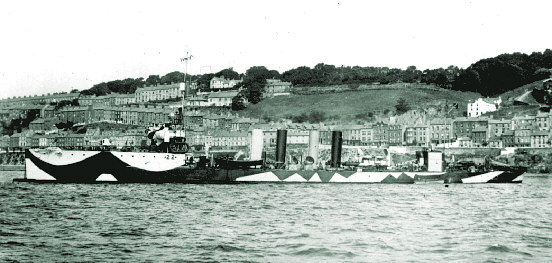 Destroyer USS Bulmer (DD-222) at Queenstown, IrelandCrisis at Sea: The United States Navy in European Waters in World War I, by William N. Still, Jr., Florida University Press, 2007, 741 + xix pages, photos, maps, index, ISBN 978 0 8130 2987 0, $100 cloth. Middle monograph in a series of three covering the U.S. Navy in European waters from 1865 though 1941. (order from publisher)
| ||||||
| ||||||
| The following are thanked for their contributions to this issue of the Trip-Wire: Jerry Beach, Donna Cunningham, Tony Langley, Christina Holstein, Tony Noyes, Andy Melomet, Kimball Worcester, and Len Shurtleff. The table of US wars is from USA-Today. Also, thanks to the gentleman who sent me the Monk Eastman photos, sorry, but I lost your name. Until next month, your editor, Mike Hanlon. | SUBSCRIBE TO THE TRIP-WIRE (Or send it to a friend.) (Or send us a comment on the TRIP-WIRE) CLICK HERE TO CONTACT US VIA EMAIL |
For further information on the events of 1914-1918
and membership information visit the Directory Pages of:
|

